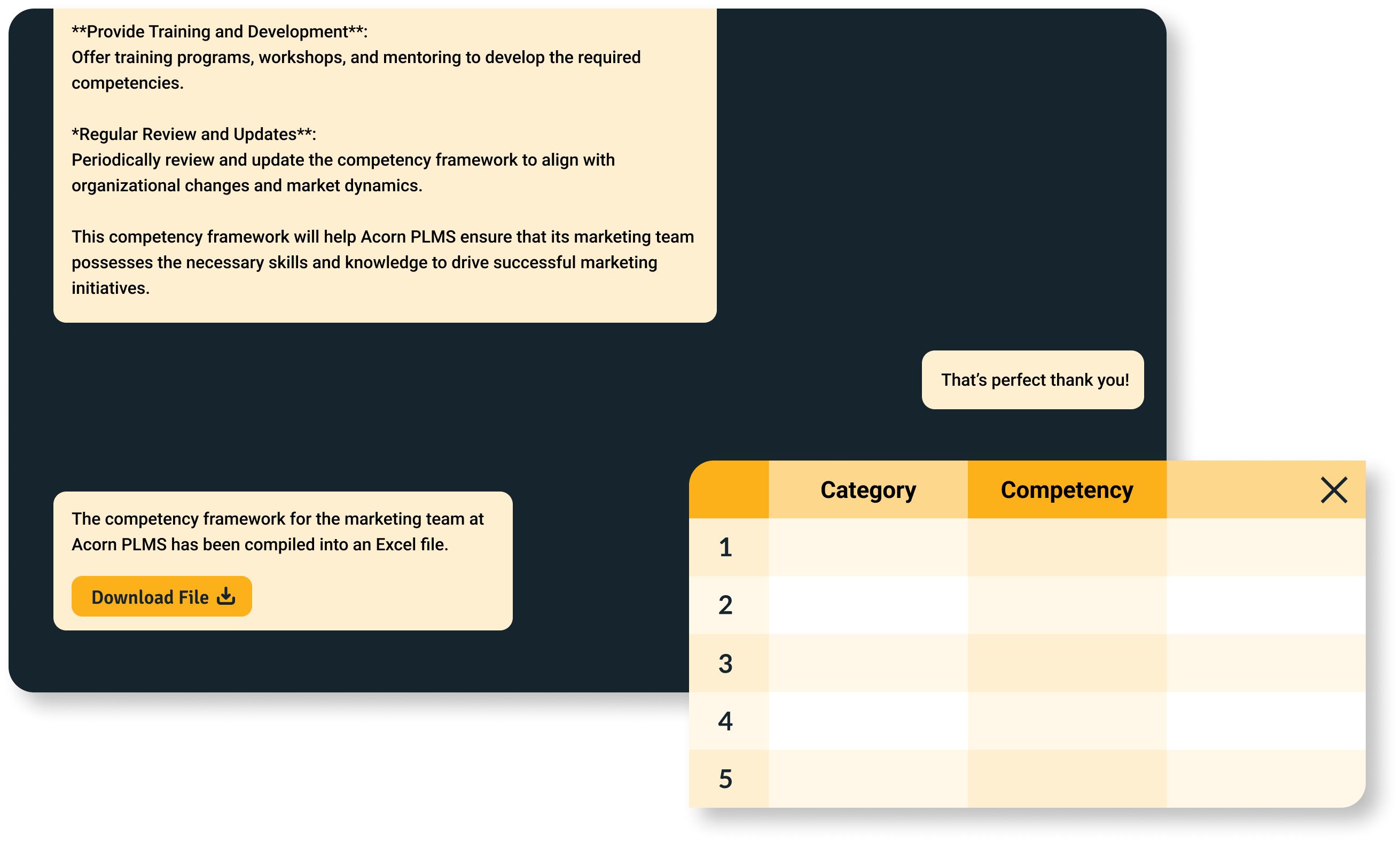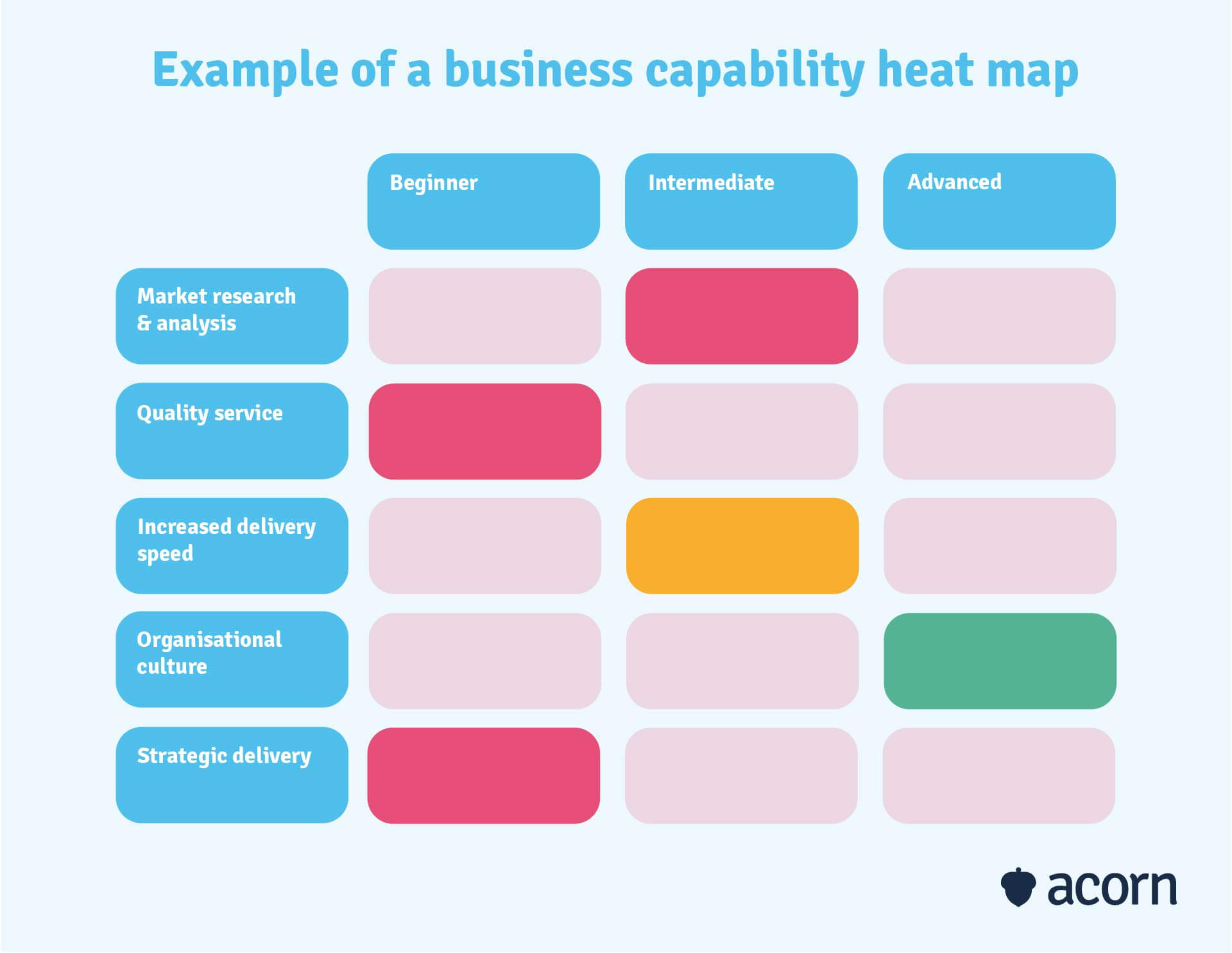How to Use a Business Capability Heat Map to Support Organizational Strategy
Reading Time:

Lead the pack with the latest in strategic L&D every month— straight to your inbox.
SubscribeWhen it comes to strategic planning, you want to know that you’re forging the best path ahead.
Business capabilities provide you with that direction—when they’re utilized and communicated properly. They help in outlining effective business processes to drive your organisation’s value streams.
This is where business capability maps come in handy—more specifically, heat maps. In this guide, we’ll explore how capability heat mapping works, and how it can support business objectives and organizational strategy.
What is a business capability heat map?
A business capability heat map is a visual representation of business capabilities, their relationships to each other, and their importance to the organization. It helps leaders assess current strengths and weaknesses, while also prioritizing which capabilities need investment for future growth.
Think of it as a dashboard for strategy execution: a capability heat map shows not just what you’re good at today, but where gaps could block tomorrow’s success.
What is the business impact of capability heat mapping?
Business capabilities are the what behind what an organization does, making them crucial to business functions. They inform business goals as much as they’re shaped by them. Mapping capabilities is how you align strategy with execution.
When you know which capabilities are most critical, you can focus L&D initiatives, allocate resources, and plan investments around the areas that actually move the needle. This helps in closing the strategy-execution gap, meaning you have a roadmap of how you’re going to achieve what you want to do.
Closing this strategy-execution gap is why we here at Acorn have created the first-ever performance learning management system (PLMS). Instead of drowning people in generic training, a PLMS ties learning directly to the capabilities your business actually needs. That way, every employee from new starter to C-suite builds the know-how that drives real performance, not just course completions. By basing development on capability mapping, you close the gap between “what we want to do” and “what actually gets done”.
Done well, capability heat mapping drives:
- Better agility. You’ll understand where you’re strong and where you’re vulnerable, giving you the flexibility to respond quickly to market changes.
- Smarter resource allocation. Investment flows to the most strategically important capabilities, reducing waste.
- Greater efficiency. Closing capability gaps helps streamline processes, reduce costs, and improve productivity.
- Stronger decision-making. Leaders make calls with a clear view of organizational strengths and weaknesses, from talent planning to tech adoption.
How to create a business capability heat map
So, how do you create business capability heat maps? Heat mapping business capabilities can be done in five steps.
Step 1: Identify the key capabilities
Start by listing the business capabilities you need to deliver on strategy. This isn’t just about internal brainstorming—scan your industry, customers, competitors, and market trends. Engage senior leaders to make sure what you record truly reflects strategic priorities.
When you identify your crucial business capabilities, don’t just record their names. Remember: capabilities are the “what,” not the “how.” Defining them properly helps link strategy to execution and gives L&D and HR a clearer view of where to target development.

Define key capabilities in less time than it takes to make a cup of coffee with our Capability Assistant.
BUILD YOUR FRAMEWORKStep 2: Assess your existing capabilities
Once you know the capabilities needed to deliver strategy, the next step is working out how well your organization already performs against them. This is less about ticking off activities and more about measuring how consistently and effectively those capabilities are showing up in day-to-day work.
There are a few ways to assess this:
- Capability assessments: Frequent (not just annual) evidence-based reviews of each employee’s capabilities set an up-to-date foundation for what your organization has the capacity to do.
- Performance data: Look at the KPIs and outcomes linked to specific capabilities (e.g., customer satisfaction scores for Customer Management capability) to see how proficiency translates into impact.
Think of it as taking a baseline: where are you confident today, and where do you need to build capability to stay competitive? Those gaps are your first signals for where to invest, because without the right capabilities in place, strategy won’t get executed.
Read the guide: How Team Leaders Can Assess Capabilities →
Step 3: Define future capabilities
Capabilities aren’t static. You also need to forecast what capabilities will matter most tomorrow. This often means scanning the environment (industry shifts, market changes, regulation, technology disruption) and stress-testing your framework against different scenarios.
Not every capability will be brand new. Sometimes, the future need is a deeper maturity level of what you already have. For example, “Digital Marketing” might evolve into “AI-Powered Campaign Management.” Others may be entirely new—like AI governance or sustainability reporting—that don’t yet exist in your framework.
The goal is to define clear, actionable targets for capability building, so you know where to invest before you feel the pain.
Step 4: Analyze the capability gap
Here’s where the “heat” comes in. Gap analysis is where you overlay the current state against the future state.
Compare today’s proficiency levels with the future state you’ve defined. Which capabilities are strong and resilient? Which are underdeveloped or at risk of dragging down strategy? Which might be missing entirely?
But don’t just look at weak areas—consider what might be missing altogether. Emerging technologies, regulations, or market shifts often demand entirely new capabilities that aren’t in your framework yet, like the aforementioned AI-led marketing capability. If you only measure gaps in current capabilities, you’ll miss the disruptive needs that aren’t even on your radar yet, and position HR as a reactive business function rather than a strategic leader.
A capability gap analysis should therefore answer three questions:
- What do we do well now (strengths)?
- Where are we underdeveloped (weaknesses)?
- What don’t we do at all, but will need to (missing capabilities)?
This gives you a holistic view of risk and opportunity. Some gaps will be low urgency (i.e., they won’t impact you for years), while others pose immediate business risk. The art here is in prioritization: focus resources on the gaps that most threaten business outcomes, while also building a runway for the “missing” capabilities you’ll need to stay competitive.
Read the guide: How to Find Workforce Gaps with a Capability Gap Analysis Report →
Step 5: Create and use the heat map
Finally, bring it all into one visual. Plot your current and future capabilities on a grid, with proficiency on one axis and capability importance on the other. Apply a color code (green = strong, yellow = moderate, red = weak/missing) to instantly show where resources and L&D should be focused.

The heat map then becomes a living tool for strategic planning—used not once and filed away, but continuously updated as market conditions and business goals shift.
The risks of not using a business capability heat map
Skipping capability heat mapping can widen the strategy-execution gap. Without it, business initiatives risk being scattershot and under-resourced.
You open your organization up to business risk, such as:
- Misaligned strategy and business capabilities, meaning the work people do may not drive strategy at all.
- Talent gaps, since you won’t understand the skills, behaviors, and knowledge required of employees to meet business objectives. That can lead to poor hiring decisions or lacking L&D initiatives, particularly because it will be unclear which capabilities should be prioritized for development.
- Wasted resources, leading to wasted time, money, and effort. It could also mean a bad reputation among employees and potential recruits, or even potential customers.
- Decreased agility and capacity for risk management, because critical gaps go unnoticed until it’s too late.
- Lack of data-driven decision-making. Leaders will lack the data to make confident, strategic calls.
- Lack of buy-in from stakeholders. You know what they will think? That L&D and HR are disconnected from strategy, undermining investment and credibility.
Key takeaways
Business capability heat maps aren’t a “set and forget” exercise. They’re a living tool to ensure strategy and execution stay aligned.
Remember, the five key steps to capability heat mapping are:
- Identify core business capabilities
- Assess the capabilities you currently have
- Define the capabilities you will need in the future
- Evaluate the gap between and set attainable goals
- Use the heat map to track your progress towards organizational priorities.
By treating capability heat maps as a strategic habit, not a one-time exercise, you can align talent, investment, and development directly to performance. That’s an outcome no stakeholder can afford not to buy into.